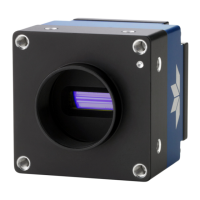Linea SWIR GigE Series Camera Additional Reference Information
109
Additional Lens Parameters (Application Specific)
There are other parameters to consider while meeting the requirements of the vision application.
• Focal Length: Defines the focus point of light from infinity.
See Camera Specifications — Back Focal Distance.
• Field of View: A lens is designed to image objects at some limited range, at some positive or
negative magnification. This defines the field of view.
• F-Number (aperture): The lens aperture defines the amount of light entering. Lenses may
have fixed or variable apertures. Additionally the lens aperture affects Depth of Field and
defines the distance range when the lens is focused at some specific distance.
• Image Resolution and Distortion: As a general definition of image quality, a lens with poor
resolution will not be in focus when used to image fine details.
• Aberrations (defect, chromatic, spherical): Aberrations are specific types of lens faults
affecting resolution and distortion. Lens surface defects or glass faults distort light and specific
colors. Aberrations are more visible when imaging fine details.
• Spatial Distortions: Describes non-linear lens distortions across the field of view. Distortion
limits the accuracy of measurements made with that lens.
Optical Considerations
This section provides an overview of illumination, light sources, filters, lens modeling and lens
magnification. Each of these components contributes to the successful design of an imaging
solution.
Illumination
The wavelengths and intensity of light required to capture useful images vary per application. The
image will be affected by speed, spectral characteristics, exposure time, light source
characteristics, environmental and acquisition system specifics, etc. Teledyne DALSA’s Web Site
introduces this potentially complicated issue. Click on Knowledge Center and select Application
Notes and Technology Primers.
Exposure settings have more effect than illumination. The total amount of energy (which is related
to the total number of photons reaching the sensor) is more important than the rate at which it
arrives.
Example: 5 mJ/cm
2
can be achieved by exposing 5 mW/cm
2
for 1ms just the same as exposing an
intensity of 5 W/cm
2
for 1 ms.
Light Sources
Keep these guidelines in mind when selecting and setting up a light source:
• LED light sources are inexpensive and provide a uniform field with a longer life span compared
to other light sources.
• Halogen light sources generally provide very little blue relative to infrared light (IR).
• Fiber-optic light distribution systems generally transmit very little blue relative to IR.
• Some light sources age and produce less illumination. A light source may produce progressively
less light in some areas of the spectrum.

